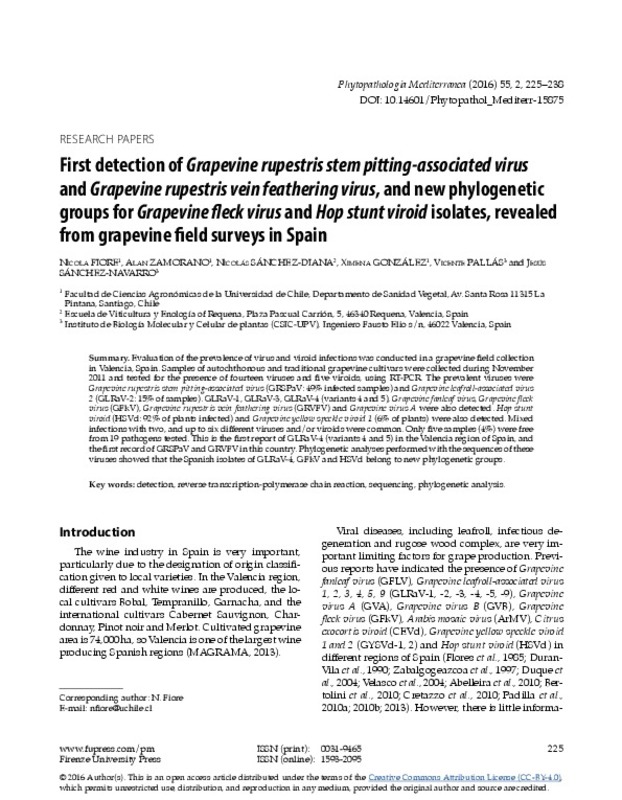|
Resumen:
|
[ES] El virus de las venas amarillas del pimiento 5 (PeVYV-5), un virus con genoma de RNA de simple cadena y polaridad positiva perteneciente al género Polerovirus (familia Luteoviridae), fue detectado por primera y única ...[+]
[ES] El virus de las venas amarillas del pimiento 5 (PeVYV-5), un virus con genoma de RNA de simple cadena y polaridad positiva perteneciente al género Polerovirus (familia Luteoviridae), fue detectado por primera y única vez en nuestro país en 2013. Este virus está estrechamente relacionado con al menos diez especies virales (englobadas bajo el acrónimo PeVYV seguido por un número) descritas en distintas partes del mundo, una diversificación que parece haber sido el resultado de mutaciones y/o recombinaciones, fenómenos frecuentes en virus de RNA y, de forma remarcable, en polerovirus. A pesar de que cualquiera de estos virus constituye una amenaza importante para el cultivo de Capsicum spp., desde la detección del PeVYV-5 y posterior secuenciación de su genoma en 2018, no hay más datos publicados sobre la presencia y/o variabilidad de este virus (o de cualquier otro PeVYV) en España. Recientemente, se han vuelto a observar los síntomas asociados al PeVYV en plantas de pimiento crecidas en invernaderos de Almería. En este trabajo se ha pretendido determinar si dichas plantas estaban, efectivamente, infectadas por PeVYV y, en tal caso, por qué especie concreta. Mediante hibridación molecular con sondas no radioactivas y RT-PCR se ha podido constatar la presencia del PeVYV-5 en algunas de ellas. Un análisis de la distribución y acumulación de este virus en plantas infectadas ha mostrado que los frutos presentan una carga viral superior a la de los peciolos, los pedúnculos de frutos y/o las hojas. La comparación de secuencias derivadas de dos regiones del genoma de los aislados del PeVYV-5 identificados en este trabajo, ha mostrado una heterogeneidad molecular considerable tanto a nivel nucleotídico como aminoacídico, lo que subraya la gran capacidad evolutiva de este patógeno.
[-]
[EN] The Pepper vein yellows virus 5 (PeVYV-5), a virus with a single-stranded RNA genome and positive polarity belonging to the genus Polerovirus (Luteoviridae family), was detected for the first and only time in our ...[+]
[EN] The Pepper vein yellows virus 5 (PeVYV-5), a virus with a single-stranded RNA genome and positive polarity belonging to the genus Polerovirus (Luteoviridae family), was detected for the first and only time in our country in 2013. This virus is closely related to at least ten viral species (included under the acronym PeVYV followed by a number) described in different parts of the world, a diversification that seems to have been the result of mutations and/or recombinations, frequent phenomena in RNA viruses and, remarkably, in polerovirus. Despite the fact that any of these viruses constitutes an important threat to the cultivation of Capsicum spp., since the detection of PeVYV-5 and subsequent sequencing of its genome in 2018, there are no more published data on its presence and/or variation of this virus (or any other PeVYV) in Spain. Recently, the symptoms associated with PeVYV have been observed again in pepper plants grown in greenhouses in Almería. In this work we have tried to determine if these plants were, indeed, infected by PeVYV and, if so, by which specific species. By means of molecular hybridation with non-radioactive probes and RT-PCR it has been possible to verify the presence of PeVYV-5 in some of them. An analysis of the distribution and accumulation of this virus in infected plants has shown that the fruits present a viral load higher tan that of the petioles, fruit peduncles and/or leaves. The comparison of sequences derived from two regions of the genome of the PeVYV-5 isolates identified in this work has shown considerable molecular heterogeneity both at the nucleotide and amino acid levels, which underlines the great evolutionary capacity of this pathogen.
[-]
|




![[Cerrado]](/themes/UPV/images/candado.png)




